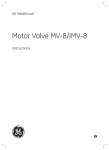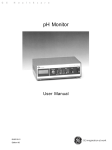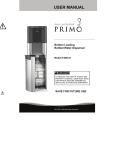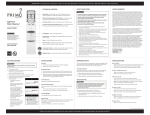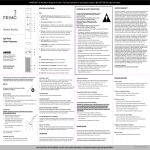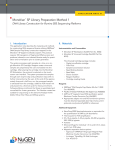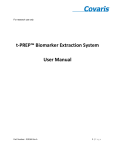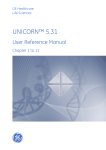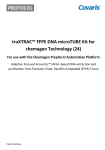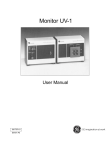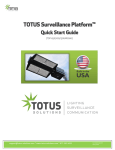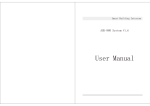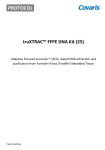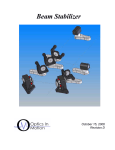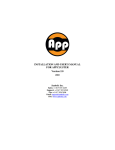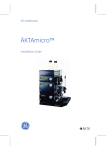Download マニュアル Motor Valve MV-7/IMV-7
Transcript
Motor Valve MV-7/IMV-7 INSTRUCTIONS 1. Introduction Motor Valves MV-7/IMV-7 are a 3-position, 7-port motorized valves designed to he used as automatic sample injection valves or system valves. The valves have 3 positions: LOAD, INJ, WASH. The port communications for these positions are illustrated in Fig I. A channel plate inside the valve body is rotated to line-up the various ports on the valves. MV-7/IMV-7 are controlled from the liquid Chromatography Controller LCC-500, LCC-500 Plus, LCC 500 CI or LCC-501 Plus, which can control up to 6 Motor Valves MV-7/IMV-7 as well as selection valves MV-8/IMV-8. The Motor Valves can also be operated from controlling software such as UNICORN™ or FPLCdirector™. Combining the MV-7/IMV-7 and MV-8/ IMV-8 (8-port) valves provides automatic flow control for multiple or repeated sample injections, column and solvent switches and fraction collection. The main different between MV-7 and IMV-7 is the diameter of the flow channels. The diameter of the flow channels for MV-7 is 0.6 mm and for IMV-7 is 1.2 mm, which allows higher flow rates at lower back pressure. MV-7 is normally used in FPLC™System. IMV-7 is normally recommended for BioPilot™System but can also be used in FPLC System. In this manual the LCC-500, LCC-500 Plus, LCC-501 CI and LCC-501 Plus will be referred to as the controller. Only when diffrences appear will specific names be used. 2. Unpacking Please check delivery against the packing list. 3. Description 3.1 Functional design Motor Valve MV-7/IMV-7 consists of two main parts, the housing which encloses the motor and the electronics and the valve body with the central core. The central core can be rotated 360° inside the housing but when controlled from the controller the shortest way to the next position is always chosen. This means that the valve only rotates a maximum of 180° inside the housing. As the core in turned by the motor, flow channels connect two peripheral ports on the valve body (Fig. 1), allowing clear liquid paths. The peripheral port numbers are marked on the valve body directly above each port. If used as an automated injection valve, the three valve positions correspond to the following operations: LOAD – the sample loop is filled, INJ – the sample is applied to the column, WASH – solvent change-over can be performed without disconnecting the column from the system. Valve switching is controlled from the controller by reading the actual position of the valve using signals from a code plate within the valve housing. The programmed commands from the control unit cause the motor to run until the valve has reached the desired position. 56-1153-36 Edition AD Fig. 1. Three operating positions of the Motor Valve MV-7/IMV-7. 3.2 Specifications MV-7 Maximum operating pressure: Back pressure at 1000 ml/hr: Back pressure at 6000 ml/h: Wetted material: Angle of rotation: Dead volume between ports: Diameter of flow channel: Motor: Connector: IMV-7 5 MPa (50 bar, 710 psi) 2 MPa (20 bar, 285 psi) 0.3 MPa (3 bar, 45 psi) – – PEEK + 20% PTFE 360° 0.02 MPa (0.2 bar, 2.8 psi) PEEK + 20% PTFE 360° ports 1-2 7.0 µl 2-3 ports 2-4 3-5 4-6 8.3 µl 5-7 6-7 1-7 ports 1-2 2-3 ports 2-4 3-5 4-6 2 ports 5-7 6-7 1-7 0.6 mm 24 V DC D-type, 9 pin on cable 1.2 mm 24 V DC D-type, 9 pin on cable 6.0 µl 10 µl 20 µl For complete description of pin configuration see Section 7, Remote connection. 3.3 Chemical resistance The valve body in contact with the solvent is made of PEEK + 20% PTFE. This is resistant to organic solvents and salt buffers commonly used in a biochemical laboratory. The valve can be used in a pH range of 2-13. If very strong acids (pH <2) or bases (pH >13) are used, the valve should be rinsed immediately afterwards. Fig.2. Motor Valve MV-7 mounted onto a chromatography rack. 4. Installation 4.1 Mounting the MV-7/IMV-7 The valve is fixed in place by screwing the support rod into the valve body and attaching the road to a laboratory rack. Mount the valve so the valve body is facing down. When mounting valves into an automated FPLC System, it is recommended to use the Chromatography Rack (Code No. 18-1031-75). The chromatography rack is supplied with a number of laboratory rods and clamps which makes the mounting of valves and other accessories simple and convenient. (Fig. 2). To mount the valve in the BioPilot System, please refer to the BioPilot System User Manual. 4.2 Tubing A tubing connection consists of three parts: flanged tubing, nipple and nipple screw. (Fig. 3). Capillary tubing for FPLC System with 0.5 mm i.d. (Code No. 19-7477-01) and for BioPilot System with 1.2 mm i.d (Code No. 19-4370-01) are supplied in two meter lengths and can be cut to any appropriate length. For flanging, the Flanging/Start Up Kit, 120 V (Code No. 19-5079-01) or 220 V (Code No. 19-5090-01) and Flanging/ Start Up Kit for BioPilot 120 V, Code No. 18-4603-70 or 220 V, Code No. 18-4603-71 is necessary. If you are using tubing other than that supplied, the flange should have a flat, smooth surface and a diameter of approx. 3 mm. When connecting the tubing to the valve ports, finger tighten the tubing connectors into the valve body and the turn them a further 45° with the plastic wrench supplied. Note: Do not use standard wrenches to tighten the tubing connectors. Do not overtighten the tubing connectors, they are designed to seal up to 100 bars when flanged properly. If the connector leaks after it has been tightened with the plastic wrench, check the flange and make a new one if needed. Fig.3. Tubing connection. 4.3 Assorted loops and Superloop Supplied with the Motor Valve MV-7/IMV-7 is a set of sample loops (25, 50, 100, 200 and 500 µl). Sample loops 1 ml and 2 ml can be ordered as accessories. If volumes larger than 2 ml will be injected, a 10 ml or 50 ml Superloop should be used. A 150 ml Superloop is available for use with BioPilot System. The Superloop is an accessory which allows large sample volumes to be applied via an MV-7/IMV-7 valve without unnecessary sample dilution. It is used in the same way as a large sample loop, but avoids the tailing which results when using a very large sample loop. Examples of how to inject samples using the sample loops and/or Superloop are given in Section 6, Application. 4.4 Connection to the controller After mounting the Motor Valve MV-7/IMV-7 connect the valve to the controller by plugging the D-connector into one of the of the sockets on the rear panel if the controller marked VALVE 1-6. 4.5 Valve position guide The self-adhesive sticker which is supplied with the valve, may be attached to the valve housing to provide a handy reference to the connection scheme. 5. Operation 5.1 Principle Valve switching is controlled from the controller or controlling software either by manual settings or within programmed methods. During a method run, a valve is switched at a programmed time or volume, or by the monitor signal i.e. when it passes a programmed threshold. 5.2 Programming Allowed positions for the Motor Valve MV-7/IMV-7 are 1, 2 and 3. These numbers correspond to the positions LOAD, INJ and WASH shown in Fig. 1. The home position for the valve is always position 1 (LOAD). If the valve has not been activated manually or within a programmed method, the valve is in its home position. If positions other than those described above are programmed, the controller will give a check code and the operation cannot be performed. The programmable function which is used when controlling the MV-7/IMV-7 from the controller is described in the next section. 5.2.1 Function VALVE POS. To activate a valve MV-7/IMV-7, enter the valve number corresponding to the socket number on the rear panel of the controller, together with the position number. For example, when programming a valve connected to the socket VALVE 2, to switch to position 3 enter VALVE POS. 2.3. 6. Applications 6.1 Automatic sample injection Automatic sample injections can be performed with the Motor Valve MV-7/IMV-7 using either a sample loop or Super loop. In both cases the sample is loaded with a pump. The sample can also be introduced manually into the sample loop or Superloop using the injection fill port supplied. Different port connections on the MV-7/IMV-7 are used depending on how the sample is introduced. Detailed descriptions on the port connections that should be used are given in the following sections. 6.2 Automatic sample injection using sample loops 6.2.1 Installation To prepare a valve for connection to a system, you need different tubings attached to each port. Each port numbers, its system connection and tubing type are giving below. Port No. Connects to Tubing 1 Column Screw tubing from the top of the column into port 1. 2 Sample loop or Superloop (between ports 2 and 6) Various types depending on desired volume. Flange and tubing connectors on both ends. 3 Sample pump, e.g. peristaltic pump The inlet of the pump is connected to port 3. 4 Sample Use narrow tubing (o.d. 1.8 mm, i.d. 0.5 mm) to minimize dead volumes. 5 Waste Use tubing (o.d. 1.8 mm, i.d. 1.1 mm), with flange and tubing connector on one end. 6. Sample loop or Superloop (between ports 2 and 6) See port 2. 7 Pump The outlet from the pump is connected to port 7. Flange and tubing connectors on both ends. Fig.4. Port connections when using the MV-7/IMV-7 as an automatic injection valve with a sample loop. Fig. 4. shows the complete set-up. When the valve is connected to the system, it is ready to be used as an injection valve. 6.2.2 Sample injection For first time use, flush out the entire valve with water or buffer. Position 1, LOAD In this position the column is equilibrated. When ready to load a sample onto the column, start the pump and fill the sample loop. The loop should be completely loaded. Position 2, INJECT After the loop has been loaded, the sample is injected by setting the valve in this position. After 3 to 5 loop volumes, return to position 1, LOAD. Together with one Motor Valve MV-8/IMV-8, the MV-7/IMV7 can be used for automatic sample injection of up to 8 samples. Fig. 5. illustrates a standard set-up for automatic sample injection using one MV-8/IMV-8 valve. When two MV-8/IMV-8 valves are used, the number of samples can be increased to 15, see Fig. 6. If rinsing is required between sample injections, reduce the number of sample tubes to 7 (when using one MV-8/IMV-8) and have the rinse eluent in the first tube. Rinsing the sample loop is performed when the Motor Valve MV-7/IMV-7 is in position 1 (LOAD). 6.2.3 Changing pump solvents Position 3, WASH This position is used when it is necessary to change solvents in the pump or when synchronizing the pumps (i.e. functions WASH and SYNC in the controller). The solvent bypasses the column by flowing directly from the pump to waste. 6.3 Automatic sample injection using Superloop If applying large volume of diluted sample onto the columns, a Superloop should be used. There are two versions of the Superloop, holding up to 10 ml or 50 ml samples. A 150 ml Superloop is available for use with BioPilot System. A Superloop can also be used in multi-dimensional separation schemes where fractions from one column are automatically transferred via the Superloop to another column by column switching. (See figure 5 and 6). Fig. 5. A Motor Valve MV-7/IMV-7 used in combination with a MV-8/IMV-8 valve for automatic sample injection. Fig. 6. A Motor Valve MV-7/IMV-7 used in combination with two MV-8/IMV-8 valves for automatic sample injection. 6.3.1 Installation When using a Superloop instead of sample loop, the installation is identical with the exception that the sample is introduced via port 3 using a peristaltic pump or, when working with column switching, the Superloop is loaded with the fraction from another column via port 3 (see Fig. 7). 6.3.2 Sample injection The sample injection procedure is identical to that used when injecting samples with sample loops. Position 1, LOAD The sample is loaded into the Superloop by a peristaltic pump. Position 2, INJECT In this position sample is applied to the column. Depending on the experimental conditions, the loaded sample can be injected all at once or in smaller volumes. For smaller volumes, set the valve position 1 LOAD after the desired volume has left the Superloop. 6.4 Manual sample injection Fig. 7. Port connections when using a MV-7/IMV-7 as an automatic injection valve with the Superloop. The sample can also be manually injected into the sample loop or Superloop using the Injection fill port supplied. The sample loop can be partially or completely loaded with a syringe. We recommend you to use injection needles, o.d. 0.55 mm (Code No. 18-7143-01). The sample is automatically applied to the column by setting the valve to position 2 INJ. 6.4.1 Installation 6.5 The MV-7/IMV-7 as a system valve The injection fill port is connected to valve port 3 and port 4 serves as a waste port for the sample. To install the injection fill port, proceed according to the procedure described below, see also Fig. 10. 1. Check to see that the Teflon ring, needle guide and inner sleeve are inside the adaptor screw. 2. Loosen the adjusting screw from the adaptor screw. 3. Carefully thread the adaptor screw into the valve distributing plate at port 3. The adaptor screw must be screwed into the valve body correctly or the threads in the distributing plate can be damaged. 4. Finger tighten the adaptor screw into the distributing plate. Make sure that the end of the adaptor screw is seated up against the PEEK surface. 5. Insert the injection needle (0.55 mm o.d.) into the injection fill port. 6. Tighten the adjusting screw until the Teflon ring has formed a seal around the needle´s tip. When the seal is adjusted correctly, it feels as if you are penetrating a septum at the end of the injection fill port. The seal should provide easy insertion and removal of the needle. The injection fill port is now installed properly. As a system valve, the MV-7/IMV-7 can automatically connect two columns to a single pump and detector system. With this set-up, Column I or Column II is selected by changing valve positions from 1 LOAD to 2 INJ (Fig. 8). 6.4.2 Sample injection Inject the sample in valve position 1 LOAD. 6.6 Automatic column backflush To reduce build-up of micro-particulate matter in the column inlet, routine backflushing of the column is strongly recommended. The table below describes the MV-7/IMV-7 port connections for automatic column backflushing (see Fig. 9 a, b, c). Port Number 1 2 3 4 5 6 7 Connected to column monitor port 4 port 3 waste column A/B pump outlet Valve position 1 2 3 Function down-flow through the column. Fig- 9 a. upward flow through the column, Fig. 9. b. changes solvent without altering the direction of flow, Fig. 9 c. Position 1 Down flow through the column. Fig. 9 a. Down-flow through the column. Fig. 8. The MV-7/IMV-7 as a system valve. Position 2 Position 1 Upward flow through the column. Permits column by-pass with continuous monitoring of pump effluent. Fig. 9 b. Upward flow through the column. Fig. 10 a. Column by-pass flow. Position 3 Position 2 Permits automatic solvent changeover in the A/B pumps, pumping the liquid directly to waste not via the column. Down flow through the column. Fig. 10 b. Down-flow through the column. Fig. 9 c. Solvent changes without altering the flow direction. 6.7 Automatic column by-pass This application monitors solvent change-over and system cleaning procedures. A monitor and recorder document and confirm successful solvent changeover or cleaning. The table opposite describes the MV-7/IMV-7 port connections for automatic column by-pass (see Fig. 10 a, b, and c). Port Number 1 2 3 4 5 6 7 Valve position 1 2 3 Connected to port 2 port 1 monitor not connected 1 MV-8 central port column A/B pump inlet Function column by-pass flow, Fig. 10 a. down-flow through the column, Fig. 10 b. solvent change-over, Fig 10 c. 8. Valve maintenance and repair Position 3 Permits solvent changeover. The valve can be disassembled for cleaning or solvents may be pumped through to wash it out. Suitable cleaning solvents are water, ethanol, 75% CH3COOH, 0.2 M NaOH and detergents. When using cleaning agents other than water, always rinse the valve with water as the final step. 8.1 Disassembly Fig. 10 c. Solvent change-over 7. Remote connection Active Pin voltage Function 1 +24 V Supplies power to the motor and relay. For power consumption see pins 2 and 6. 2 0 Controls the valve rotation (Sink min. 30 mA, for clockwise rotation.) 3 0-1.5 V indicates the valve position match. When active (in position) the valve position can be read on pins 8 and 9 (address pins). 4 - Signal ground voltage reference for the signals listed in this table. 5 +5 V Supplies power to the LEDs in the valve. Min. 80 mA. 6 0 Controls the start/stop function of the motor. Sink min. 1 A to start, then approx. 0.3 A while running. Short circuit to pin 1 to stop. 8 min. 3 V Indicates the valve address BIT 1. See also table below. 9 min. 3 V Indicates the valve address BIT 0. See also table below. Codes for the 3 valve positions are shown in table below. Position Address BIT 1 BIT 0 Position match 1 2 3 0 1 1 1 0 1 0 0 0 1 = 3-5 0 = 0-1.5 V Note: The motor Valve MV-7/IMV-7 is designed to be controlled by the controller. If the MV-7/IMV-7 will be controlled from other equipment (e.g. a microprocessor) a 10 kΩ pull-up resistor to +5 V must be connected to pins 3, 8 and 9 of the Dconnector of the MV-7/IMV-7. See Figure 11. 1. Set the valve to position 1 LOAD before disconnection it from the controller. 2. Remove the four Allen head screws on the bottom of the valve. Loosen each one equally in turn until the bottom plate comes off parallel to the valve body. 3. Slide these screws out with the stainless steel plate. 4. Remove the distributing plate containing the 7 ports. 5. Remove the channel plate and replace if necessary. 6. Place the channel plate and the distributing plate into an ultrasonicator with an appropriate wash solution. These two parts are also the only parts likely to need replacement. They are supplied together as spare parts in the Valve V-7 kit (Code No. 19-7805-01) and the MV-7 Valve kit (Code No. 18-4594-01). Replace these when worn. 7. Reassemble the valve. Locate the short straight channel in the channel plate between ports 2 and 3. When properly aligned, snap the channel plate onto the valve axle. When reassembling, make sure that the blank port (filled) in the distributing plate aligns with position number 8 marked on the aluminium valve body. Also the four Allen head screws on the bottom of the valve should be tightened equally in turn until the bottom plate is fixed to the valve body. Take care not to overtighten the Allen screws to avoid rounding the heads. Fig. 11. Disassembled Motor Valve MV-7/IMV-7. 8.2 Repairing the injection fill port See Figure 12. The Teflon ring and needle guide sometimes need replacement. If the ring has become splayed or the guide scratched, they should be replaced. The Teflon ring and needle guide are supplied together as an Adaptor repair kit (Code No. 19-7818-01). To replace these parts: 1. Detach the injection fill port from the valves distributing plate. 2. Unscrew the adjusting and adaptor screws. 3. Push the needle guide and its attached Teflon ring out of the adaptor screw. 4. Replace these two parts and reassemble the injection fill port as shown in Figure 12. Remember to follow the proper procedure for reconnecting the injection fill port. Important Information Sepharose is a trademark of Amersham biosciences Limited. Amersham and Amersham Biosciences are trademarks of Amersham plc. Triton is a trademark of Union Carbide Chemicals and plastic Company Inc. © Amersham Biosciences AB 2002 - All rights reserved. 9. Spare parts and accessories Spare parts MV-7 Designation Code No. Valve V-7 kit Allen screw (M3x20) Adaptor repair kit 19-7805-01 19-7564-01 19-7818-01 No. per pack 1 4 1 Accessories MV-7 Designation Capillary tubing (o.d. 1.8 mm, i.d 0.5 mm) Tubing connectors Flanging/Start Up kit, 120 V 220 V Motor Valve MV-8 Assorted sample loops 25 µl (o.d. 1.8 mm, i.d. 0.5 mm) 50 µl (o.d. 1.8 mm, i.d. 0.5 mm) 100 µl (o.d. 1.8 mm, i.d. 0.5 mm) 200 µl (o.d. 1.8 mm, i.d. 0.8 mm) 500 µl (o.d. 1.8 mm, i.d. 0.8 mm) Injection needles, o.d. 0.55 mm Sample loops 1 ml, 2 ml Superloop 10 ml Superloop 50 ml Code No. 19-7477-01 19-7476-01 19-5079-01 19-5090-01 19-7520-01 18-0404-01 18-7143-01 18-5897-01 19-7585-01 19-7850-01 No per pack 2m 5 1 1 1 1 of each 6 1 of each 1 1 Spare Parts IMV-7 Designation Code No. Valve Kit IMV-7 AlIen screw 18-4594-01 19-7564-01 Amersham Biosciences UK Limited Amersham Place Little Chalfont Bucks, Buckinghamshire HP7 9NA England 1 2 Amersham Biosciences Europe GmbH Munzinger Strasse 9 D-79111 Freiburg Germany Accessories IMV-7 Designation Code No. No. per pack Tubing (i.d. 1.2 mm, o.d. 1.8 mm) Tubing connectors 1.8 Tubing (i.d 1.9 mm, o.d 2.7 mm) Tubing connectors 2.7 Flanging Tip Kit i.d. 1.2 Flanging Tip Kit i.d. 1.9 Flanging/start up Kit for BioPilot 120 V Flanging/start up Kit for BioPilot 220 V Motor Valve IMV-8 Superloop 150 mI 19-4370-01 19-7476-01 18-8207-01 18-4652-01 18-4597-01 18-4596-01 2m 5 2m 5 1 1 18-4603-71 18-4586-01 18-1023-85 Amersham Biosciences AB Björkgatan 30, SE-751 84 Uppsala Sweden Amersham Biosciences Corp 800 Centennial Avenue, Piscataway, New Jersey 08855 USA No. per pack 18-4603-70 A copy of the Amersham Biosciences Conditions of Sale is available on request. Amersham Biosciences K. K. Sanken Building, 3-25-1 Shinjuku-ku, Tokyo 169-0073 Japan PRINTED IN SWEDEN BY TK I UPPSALA AB, FEB. 2003 Fig. 12. Disassembled injection port. All goods and services are sold subject to the Conditions of Sale of the company within the Amersham Biosciences group wich supplies them, save where otherwise agreed in writing. Under the terms of such Conditions of Sale, Amersham Biosciences warrants that the Goods (as defined) meet written specifications at the time of shipment and that Equipment (as defined) shall be free of defects in workmanship or materials under normal usage for a period of one year, but such warranty will be rendered void in the case of abnormal working conditions, failure to follow Amerskam Biosciences instructions and/or other misuse. AMERSHAM BIOSCIENCES EXPRESSLY EXCLUDES ALL OTHER WARRANTIES, REPRESENTATIONS, TERMS AND CONDITIONS (STATUTORY, EXPRESS IMPLIED OR OTHERWISE) AS TO QUALITY, CONDITION, DESCRIPTION, MERCHANTABILITY OR FITNESS FOR PURPOSE (EXCEPT FOR THE IMPLIED WARRANTY OF TITLE). AMERSHAM BIOSCIENCES SHALL HAVE NO LIABILITY FOR ANY INDIRECT CONSEQUENTAL OR PUNITIVE DAMAGE OF ANY KIND FROM ANY CAUSE ARISING OUT OF THE SALE, INSTALLATION, USE OR INABILITY TO USE ANY PRODUCT OR SERVICE, INCLUDING WITHOUT LIMITATION, LOSS OF PROFITS, OR GOODWILL OR BUSINESS INTERUPTION.










